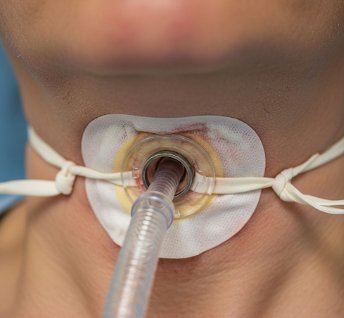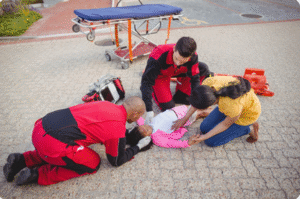Overview
A tracheostomy is a surgical procedure in which a hole (stoma) is made in the windpipe (trachea) through the front of the neck, allowing a tube to be inserted to assist breathing. It may be temporary or permanent, depending on the underlying condition.
This procedure is performed for patients who need long-term ventilation support, airway obstruction relief, or airway protection. In Korea, tracheostomy is commonly done in advanced surgical and intensive care settings, using modern equipment and techniques to ensure patient safety and comfort.
What is a Tracheostomy?
The tracheostomy provides a direct airway and helps patients breathe when normal breathing through the nose or mouth is not possible.
Common reasons for tracheostomy include:
- ✦ Severe injury or blockage of the airway
- ➤ Long-term use of a ventilator in intensive care
- ✦ Neurological conditions affecting breathing (e.g., stroke, spinal cord injury)
- ➤ Head, neck, or throat cancers
- ✦ Severe sleep apnea unresponsive to other treatments
- ➤ Severe infections or swelling obstructing the airway
What are the Benefits?
A tracheostomy can:
✅ Provide a secure airway for breathing
➤ Allow mechanical ventilation over extended periods
✅ Improve clearance of secretions from the airway
➤ Reduce risk of vocal cord injury from long-term intubation
✅ Enhance patient comfort compared to oral or nasal breathing tubes
➤ In some cases, enable speech and swallowing with specialized tubes
Procedure Details
1) How should I prepare for a Tracheostomy?
Preparation depends on whether the procedure is planned or performed in an emergency.
- ✦ Planned procedure: preoperative evaluation, blood tests, and imaging (chest X-ray, CT scan if needed)
- ➤ Fasting: no food or drink for several hours before surgery
- ✦ Medication review: blood thinners may need to be paused
- ➤ Patient education: discussion of risks, benefits, and postoperative care
- ✦ Emergency tracheostomy: performed urgently when airway obstruction occurs, with minimal preparation
2) What happens during the Tracheostomy procedure?
- ✦ Usually performed under general anesthesia if planned, or under local anesthesia in emergency cases
- ➤ A horizontal incision is made in the lower neck
- ✦ The surgeon carefully opens the trachea (windpipe)
- ➤ A tracheostomy tube is inserted into the opening
- ✦ The tube is secured in place with sutures or ties
- ➤ The patient is connected to oxygen or a ventilator if necessary
In Korea, many hospitals use percutaneous tracheostomy techniques in intensive care units, guided by endoscopy, which can be less invasive than open surgery.
3) What happens after Tracheostomy?
- ✦ Immediate care: patient is monitored in intensive care or recovery unit
- ➤ Airway management: suctioning secretions and maintaining humidified air
- ✦ Nutrition support: initially via feeding tube, later progressing to oral feeding if possible
- ➤ Speech support: some tubes allow speech with special valves
- ✦ Wound care: keeping the stoma site clean and infection-free
- ➤ Tube care: regular cleaning or replacement of the tracheostomy tube
Risks / Benefits
Possible Risks:
- ✦ Bleeding during or after the procedure
- ➤ Infection at the tracheostomy site
- ✦ Injury to nearby structures (thyroid, blood vessels)
- ➤ Air leakage under the skin (subcutaneous emphysema)
- ✦ Tracheal narrowing (stenosis) with long-term use
- ➤ Difficulty with speech and swallowing
Benefits:
- ✅ Provides a stable, long-term airway
- ✅ Reduces complications from prolonged intubation
- ✅ Can improve patient comfort
- ✅ Enables weaning from mechanical ventilation in some cases
- ✅ In Korea, advanced tracheostomy tubes and care protocols improve recovery
Recovery and Outlook
Recovery depends on the reason for tracheostomy and whether it is temporary or permanent.
- ✦ Hospital stay varies from a few days to several weeks.
- ➤ Patients and caregivers are trained in tracheostomy care (cleaning, suctioning, tube changes).
- ✦ Some patients may have the tracheostomy tube removed once they recover (decannulation).
- ➤ Long-term patients can live full lives with proper tracheostomy care.
- ✦ In Korea, patients receive rehabilitation support, speech therapy, and nutritional guidance after tracheostomy.
When To Call the Doctor
Seek medical help immediately if:
⚠ Tracheostomy tube becomes blocked or dislodged
⚠ Sudden difficulty breathing
⚠ Persistent bleeding or pus at the site
⚠ High fever or signs of infection
⚠ Swelling around the neck or stoma site
Best Korea Option / Process
Korea is highly advanced in tracheostomy care, offering:
- ✦ Modern percutaneous and minimally invasive tracheostomy techniques
- ➤ Specialized intensive care units for critically ill patients
- ✦ Experienced ENT, thoracic, and critical care surgeons
- ➤ Advanced tracheostomy tubes (speech valves, fenestrated tubes)
- ✦ Comprehensive rehabilitation programs for speech and swallowing
- ➤ International patient support with 24/7 medical assistance
Highlights of Tracheostomy in Korea
- ✅ Life-saving airway procedure for breathing difficulties
- ➤ Can be temporary or permanent depending on condition
- ✅ Korea offers advanced minimally invasive techniques
- ➤ Includes specialized speech and swallowing rehabilitation
- ✅ High survival and recovery rates with modern ICU support













